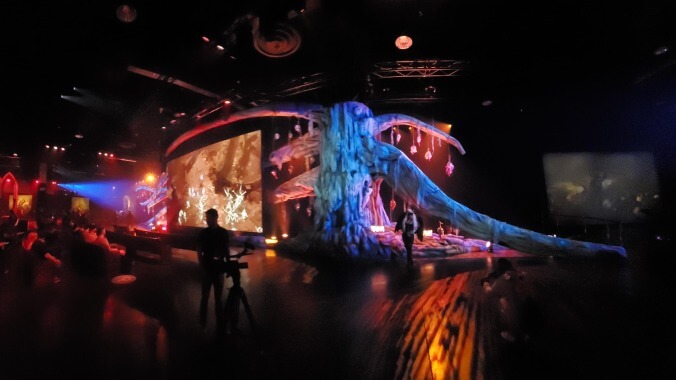We went to BlizzCon 2023 to find out if it's the future of gaming conventions
With E3 dead, and so many trailers and demos moving into online spaces, what can Blizzard's BlizzCon tell us about the future of conventions?

This story is part of our new Future of Gaming series, a three-site look at gaming’s most pioneering technologies, players, and makers.
The gaming convention has, as a form, had a damn hard couple of years. The COVID-19 lockdowns took a massive toll on a primarily in-person industry, obviously; so, too, has the rise of alternative events like Nintendo’s Direct series of online press conferences, or largely virtual industry-wide shows like Summer Games Fest or The Game Awards. (Where companies flock to roll out trailers that might once have been the highlight of a big convention showcase, supported by demos that players can have their hands on within minutes of the announcement.) The biggest potential deathknell for “traditional” cons came earlier this year, when the Entertainment Software Association announced it was canceling the 2023 (and 2024, and 2025) iterations of its Electronic Entertainment Expo, once the name in video game conventions. With E3—previously the battleground where Sony, Sega, Nintendo, and more battled desperately for the hearts and minds of a whole generation of gamers— basically moribund, we found ourselves asking: Where does the gaming convention go in 2023, and beyond? How does it weather a future where so many things now live online?
Searching for answers took us far afield—including to the halls of one of the longest-running studio-run gaming conventions in the world, Diablo creator Blizzard’s near-annual BlizzCon. Surrounded by thousands of Overwatch, Diablo, Hearthstone, and especially Warcraft fans, we spent two days wandering the halls of the Anaheim Convention Center, which had been transformed into a series of fantastical environments, filled with gothic churches, medieval taverns, and futuristic bases. (Also, people: An absolutely staggering number of people.) BlizzCon 2023 was the first in-person version of the event to be held in fully four years, after the convention went fully virtual in 2020 and 2021, and was then paused outright amidst a storm of bad publicity for the company in 2022. Sitting in its crowded opening ceremony—where fans bayed joyfully at each new gaming expansion reveal, or gave standing ovations to the company’s lead developers—we wondered: How had they pulled it off? How do you lure people back to in-person conventions after that kind of gap? What, precisely, is the the future of this kind of thing?
“Think Universal Studios,” was one thought, expressed to us by Rod Fergusson, the veteran Gears Of War developer who’s now in charge of the company’s biggest 2023 release, Diablo IV. Fergusson was telling us about his (thoroughly fulfilled) ambitions for the Diablo portion of the Con, and it wasn’t hard, after a short amount of time on the show floor, to see what he meant: Each giant room of BlizzCon was almost overwhelming in its art design, from the lurid red lights of the Diablo area (complete with massive paintings depicting scenes from the game’s lore, and an expansive tree festooned with decapitated heads running along the entire back of the hall) to the cool blues and greys of the Warcraft areas, which were filled with statues of the game’s numerous heroes. The effect, on initial look, was one of overwhelming, otherworldly grandeur. (Even if the illusion was occasionally undercut by, say, the multiple Mountain Dew-branded “Altars Of Mystic Punch” situated around the con, workers dutifully handing out plastic shot glasses of brightly colored sugar water to attendees; a reminder that no con can be so powerful as to escape the influence of its corporate partners.)
It seemed to be working, too: The throngs of people in attendance, from seemingly all demographics and walks of life, seemed suitably awed as they walked out of the California sunshine and into these impressive, distinctive spaces. More palpable, though, than the phenomenal art direction, was the social element at play: Universal Studios vibes or no, attendees were clearly feeling as much joy at the presence of each other as they were the Diablo-branded tattoo parlors or the recreations of beloved Overwatch spaces.
That’s a common element in modern con design, which puts an ever-important primacy on the human element—and in making conventions more accessible to everyone, something emphasized in our conversations with the organizers of other major conventions as we were putting together this piece. “The transition into how our audience has changed is by far the biggest leap in the past 20 years” according to Kyle Marsden-Kish, global VP of gaming for Reed Expositions, the company that puts on multiple PAX conventions every year in convention centers around the planet. Founded by the creators of the webcomic Penny Arcade in 2004, PAX has become one of the world’s largest non-studio-aligned gaming cons, and continues to thrive while older competitors (including, of course, E3, which it once operated in the shadow of) have faltered. Per Marsden-Kish, that’s come with widening its net considerably—and finding ways to bring in gamers who were already there, but who weren’t being best-served by the convention industry:
Our fan demographic has changed a lot from being primarily made of white males. It’s not that women weren’t gaming back in those days, but the con culture has gotten so much more inclusive and welcoming in a way that we, as a community, probably weren’t back in 2004 to anyone who wasn’t a straight white male. That’s something we’ve definitely tried hard to push for over the years, and we’re incredibly proud of our PAX Together program, which has evolved into an entire pillar of PAX, featuring games, panels, developers, and non-profits distributed throughout the show that was created by and for under-represented communities of gamers.
